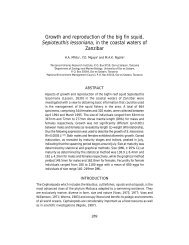gpa_east_africa_case.. - GRID Africa GeoPortal - UNEP
gpa_east_africa_case.. - GRID Africa GeoPortal - UNEP
gpa_east_africa_case.. - GRID Africa GeoPortal - UNEP
Create successful ePaper yourself
Turn your PDF publications into a flip-book with our unique Google optimized e-Paper software.
lossesHuman Health Indicator: Treatment costs, loss of work-days and loss of human lifedue to environment-related diseasesPropertyIndicator: Increment / loss of property valuesIndirect Use ValueChanges in recreation, leisure and amenity opportunities, beach stability and quality offeredto the public in and near coastal areas due to change in environmental conditions / qualityRecreation and Indicator: Number of people and cost of visiting clean and unspoiledamenitycoastal sites reflecting people’s valuation of recreation opportunitiesNon-Use BenefitsExistence value of environmental quality – biodiversityPreservation of coastal,marine and landscapequality, cultural andnatural heritageIndicator: People’s willingness-to-pay for maintaining marine andcoastal biodiversity (quantitative and qualitative information fromsurveys)3. Estimation of Environmental Costs - The Costs of InactionDirect Costs1. Tourism.The Beau Vallon Bay area attracts about 43,000 tourists a year spending about $1,152 for an8-day holiday, thus generating total gross revenue of $50.0 million a year. Recent touristarrival trends show an average growth rate of about 5% per year. This trend has beenmaintained relative to the present state of the environment, generally without major pollutionimpacts. It is certain that in the near future pollution will become a major concern. Given thetendency for increased activity and population growth, without sewage collection, disposaland treatment infrastructure environmental impacts will emerge. In that <strong>case</strong>, it is logical toassume that the growth of tourism and income from tourism will be affected through reductionof arrivals and/or prices.To set up a framework of future tourism projections under different environmental conditions,three possible tourist scenarios are examined: Two scenarios without pollution controlinfrastructure (scenarios 2 and 3), and the scenario with pollution control infrastructure:Scenarios without Pollution Control Infrastructure:• The favourable scenario (2): Under this scenario tourism is assumed to continue to growat 5% up to the year 2003, reaching just under 50,000 tourist, reflecting the absence ofimmediate serious environmental problems, remaining constant for the rest of the periodup to 2024.• The more realistic scenario (3): Under this scenario tourism is assumed to decline at anaverage of 5% a year due to environmental degradation (Reference: AppliedEnvironmental Economics in <strong>Africa</strong>, World Bank, 1995)Scenario with Pollution Control Infrastructure• Under this “with infrastructure” scenario, tourism is assumed to be able to maintain itsgrowth trend of 5% per year up to the year 2005 and grow at 2% after 2005, even thoughit may be debatable to assume that by the year 2024 tourist arrivals will be about 80,000.These scenarios are instruments to estimate the impact on tourism with and without theplanned sewerage system. On the basis of these assumptions the tourism cost ofenvironmental degradation, expressed as the difference between tourism growth withinfrastructure and tourism decline of 5% a year without infrastructure, builds up over time asshown below. Tourism expenditure is assumed at constant prices of $1,152 per tourist visit.Final Draft Report – Cost Benefit Case StudiesGPA Strategic Action Plan on Sewage, October, 200050



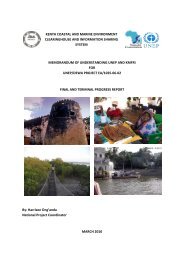
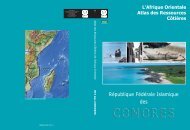
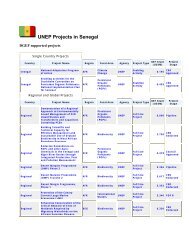

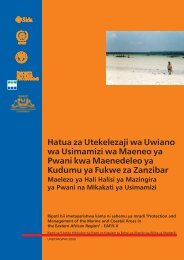
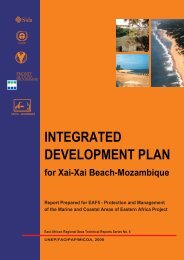
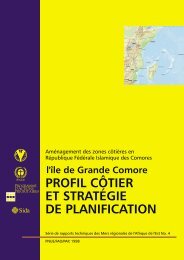
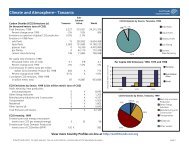

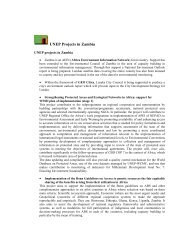
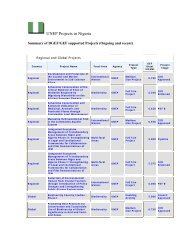
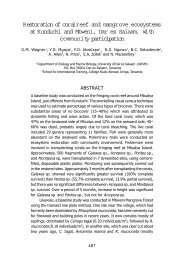
![Please Click to download [English] - GRID Africa GeoPortal - UNEP](https://img.yumpu.com/30633391/1/184x260/please-click-to-download-english-grid-africa-geoportal-unep.jpg?quality=85)
